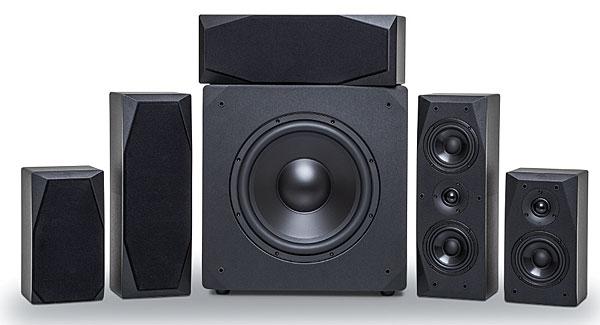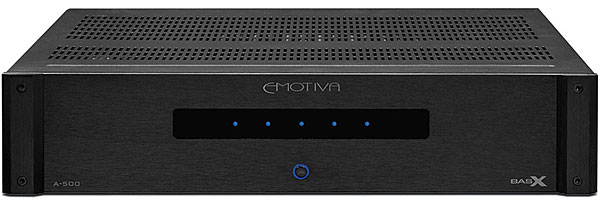Emotiva BasX System Review

THE VERDICT
Emotiva’s BasX surround processor, five-channel amp, and speakers offer an affordable and high-performing starter system that puts you into audio separates without breaking the bank.
Surround separates are generally regarded as a step up from receivers. If you want the biggest and best, and have to ask their prices, you probably can’t afford them. But ask me the prices of Emotiva’s new BasX surround preamp/processor and multichannel amplifier, along with a set of compact speakers from the same series. The answers are $599, $499, and $1,045, totaling $2,143 for a 5.1-channel system of electronics and speakers. That would buy a midpriced receiver and a decent (but probably smaller) satellite/subwoofer set. Odds are the receiver would have more features than Emotiva’s pre/pro. But those features would have to share a chassis and power supply with current-sucking, signalpolluting amp components, whereas Emotiva’s separates separate the pre/pro from the amp, offering the potential for better performance from both.
You needn’t buy the BasX separates as a pair. Perhaps you’d prefer to mate a more feature-rich pre/pro from Emotiva or a different brand with Emotiva’s multichannel amp. Or perhaps you love your old multichannel amp but want to upgrade your equally old pre/pro to something that has Ultra HD–capable HDMI. If that sounds like you, read on.
Before you do, however, let me state up front that the MC-700 pre/pro doesn’t support Dolby Atmos and DTS:X, the new height-capable surround formats. Nor will it do so in any future update. Even if it did, you wouldn’t be able to use those formats here, because the five-channel A-500 amp doesn’t have enough channels to support either height or back-surround.
If you do need an Atmos-updatable pre/pro, you can find one among Emotiva’s higher-end electronics, the X series. The 7.2-channel XMC-1 ($2,499) would support an Atmos 7.2.4 configuration with the new board (raising the price to $2,999). That model also steps up to Dirac room correction, affording a potentially large advantage in performance. XPA series power amps are available as a monoblock or in modular 2-, 3-, 5-, 7-, 9-, and 11-channel configurations. Meanwhile, Emotiva’s higher-end speaker line is the Airmotiv, which features pleated planar-magnetic tweeters and has been favorably reviewed in our January 2017 issue, also available at soundandvision.com. The line includes seven- and five-channel speaker bundles for $1,486 and $1,217, respectively.
This review covers a basic 5.1-channel system. As I stated in the blog post “Is 5.1 Obsolete?”, most of the fundamental truths of surround sound are present in a 5.1-channel system: a center channel to anchor dialogue, a soundfield that reaches to the four corners of the room, [and] a subwoofer to firm up bass.” Sticking with 5.1 is a perfectly legitimate choice to make, especially in a budget system. The fewer channels the amp’s power supply has to serve, the more oomph you’ll get out of it at a given price point.
In addition to the aforementioned MC-700 pre/pro and five-channel A-500 amp, the Emotiva BasX models under review here include the LCR speaker (three in the front), the Sat speaker (two in the rear), and the 12-inch S12 subwoofer. The speakers and subwoofer are also available in different configurations as the BasX 7.1, 5.1, and 2.1 Bundles. The BasX series has another five-channel amp, the beefier A-5175 ($799), as well as the seven-channel A-700 ($599), an eight-zone amp, a couple of what are billed as stereo preamp/DAC/tuners (one with integrated amp), three stereo power amps, and a CD player. There are also a couple of smaller subs, the 10-inch S10 ($299) and 8-inch S8 ($199).
MC-700 Pre/Pro and A-500 Amp
The MC-700 pre/pro has a heavyduty steel chassis and milled-aluminum faceplate. There are six HDMI inputs and two outputs. Three of the inputs support Ultra HD video with HDCP 2.2 DRM, ensuring that copy-protected UHD sources will play. That includes UHD passthrough but not scaling because Emotiva believes the latter does more harm than good. The HDMI version with the latest firmware is 2.0b, which supports HDR10. Dolby Vision is not supported.
MC 700 AT A GLANCE
Plus
7.1-channel analog outputs
Sub XLR-out and flexible crossovers
HDR10 video passthrough
Minus
No Dolby Atmos or DTS:X
No Dolby Vision HDR
No onboard Bluetooth or W-Fi
Audio inputs include digital coaxial, optical, and dual analog stereo. The 7.1-channel analog outputs include back-surrounds, which might be mated with the seven-channel BasX amp for a full 7.1 rig. You have your choice of XLR or RCA subwoofer-outs. Bass management allows 12- or 24-decibel-per-octave crossovers in 5-hertz steps below (and 10-Hz steps above) 80 Hz. Auto setup and room correction are via a proprietary system called Emo-Q, and a calibrated measurement microphone is included. If you have a real-time analyzer on your mobile device, a test-tone disc, and a sense of destiny, you might prefer to use the included virtual 11-band-per-channel parametric EQ. Three sets of parameters can be stored for each input.

In addition to RS-232, IR in/out, and trigger-out, the back panel has various USB jacks, two for firmware updates and one for the optional Bluetooth module ($50); there is no onboard Bluetooth, Wi-Fi, or AirPlay. None of the USB jacks can access music from a PC or external drive. The auto setup routine’s mic input is also in back, an unusual place for it, but you’re not likely to need frequent access after initial setup. On the front panel are the volume, power, and menu navigation controls, along with a minijack headphone output, which Emotiva says is backed by a high-quality headphone amp. A couple of considerate features include last video memory, which enables you to switch to an audio input while still viewing the lastselected video input, and video on standby, which enables the video display to continue receiving the last-selected video and audio source while the pre/pro is in standby mode.

Some ergonomic details suffer from the tight design budget, or simply the desire to retain a lowprofile aesthetic. The blue front-panel display is cheerful but not large enough to be read easily from across the room. The graphic user interface is visually unappealing, and it’s also sluggish, taking about seven seconds to bring up the main screen.
A-500 AT A GLANCE
Plus
80 watts Class A/B with all channels driven
Handles 4-ohm loads
Slim chassis
Minus
No XLR outputs
The remote is small, simple, and handsome. It includes the basics—input, mode, navigation—and not much more. But the trim control might come in handy. It adjusts speakers in groups. Like the remote, the manuals for the pre/pro and amp are as simple and unintimidating as they possibly could be. They are printed in a large format with readable type, have spiral-ring bindings, and are no longer than 29 pages. Flipping through them is almost a pleasure. Of course, you can download the latest version, too.

The A-500 amp has similarly heavy-duty mechanical construction and what is described as an oversized linear power supply. Despite its decidedly unbulky enclosure, it sports a Class A/B topology that is rated at 80 watts per channel with all channels driven (the toughest way to specify a multichannel amp) and up to 110 watts with two channels driven. See our Test Bench for real-world results. The back panel includes plasticnut binding posts for each speaker output, five RCA inputs, and 12-volt trigger in and out. You can switch off the front-panel status LEDs if they bug you.

In addition to glowing blue under normal conditions, the LEDs glow red to indicate problems such as excessive temperature, shorted speaker connections, and ground faults. The amp has protection for all of them, which takes the form of output stage monitoring, temperature sensing, and variable-speed fans that are thermostatically controlled. The fans are quiet; I didn’t notice them. Emotiva says none of this would inhibit the amp’s dynamic performance.
LCR, Sat Speakers, and S12 Sub
Each of the three BasX LCR speakers up front measures 16.5 inches tall x 5.75 wide by 6.88 deep; just flip those “tall” and “wide” numbers for the center speaker if you use it horizontally. Behind the fabric grille, the LCR has a 1-inch coated and fluid-cooled silk-dome tweeter with neodymium magnet. Flanking it are two 4-inch woofers with mineral-filled polypropylene cones and rubber surrounds. On the back are plastic-nut binding posts, small dual ports, and a keyhole mount. The enclosure’s front edges are sliced at top, bottom, and sides. Emotiva says this Minimum Acoustic Signature design reduces cabinet diffraction and room interaction. All speaker and sub enclosures are made of high-density fiberboard with window bracing to reduce cabinet coloration, the latter being a nice touch at this price point. And a good job they did, too: A knuckle rap produced nothing more than a sore knuckle.
The 10.5-inch-tall BasX Sat, deployed in our surround-channel positions, is a simple satellite speaker with the same drivers (minus one of the woofers). The Minimum Acoustic Signature angles are more prominent at the top than at the bottom. In back are the same terminals, single port, and mount. Both the Sat and LCR are rated at 87 dB sensitivity, which is about normal for honestly rated speakers with 4-inch woofers. However, the LCR does have greater rated power handling than the Sat, at 100 watts continuous and 200 peak versus 50 watts continuous and 100 peak. So if your room is large or your amp muscular, five of the LCRs might be called for.





























































